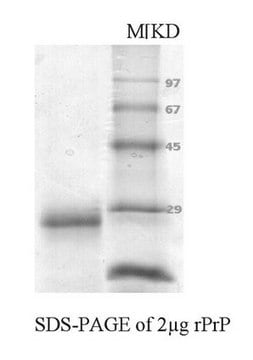P0110
Anti-Prion Protein antibody, Mouse monoclonal
clone 8H4, purified from hybridoma cell culture
Sinônimo(s):
Monoclonal Anti-Prion Protein antibody produced in mouse, Anti-AA960666, Anti-CD230, Anti-PRIP, Anti-PrP, Anti-PrP<C>, Anti-PrPSc, Anti-Prn-i, Anti-RP23-401J24.1, Anti-Sinc
About This Item
Produtos recomendados
fonte biológica
mouse
conjugado
unconjugated
forma do anticorpo
purified immunoglobulin
tipo de produto de anticorpo
primary antibodies
clone
8H4, monoclonal
forma
buffered aqueous solution
peso molecular
antigen 25-35 kDa
reatividade de espécies
bovine, mouse, monkey, human, sheep, rat
embalagem
antibody small pack of 25 μL
concentração
~1.5 mg/mL
técnica(s)
electron microscopy: suitable
flow cytometry: suitable
immunocytochemistry: suitable
immunohistochemistry: suitable
immunoprecipitation (IP): suitable
indirect ELISA: suitable
western blot: 2-4 μg/mL using mouse brain extract
Isotipo
IgG2b
nº de adesão UniProt
Condições de expedição
dry ice
temperatura de armazenamento
−20°C
modificação pós-traducional do alvo
unmodified
Informações sobre genes
bovine ... PRNP(281427)
human ... PRNP(5621)
mouse ... Prnp(19122)
rat ... Prnp(24686)
sheep ... PRNP(493887)
Procurando produtos similares? Visita Guia de comparação de produtos
Categorias relacionadas
Descrição geral
Especificidade
Imunogênio
Aplicação
- immunoblotting
- flow cytometry
- immunocytochemistry
- immunoprecipitation
- immunoelectron microscopy
- immunohistochemistry
- enzyme linked immunosorbent assay
Ações bioquímicas/fisiológicas
forma física
Exoneração de responsabilidade
Not finding the right product?
Try our Ferramenta de seleção de produtos.
produto relacionado
recomendado
Código de classe de armazenamento
12 - Non Combustible Liquids
Classe de risco de água (WGK)
nwg
Ponto de fulgor (°F)
Not applicable
Ponto de fulgor (°C)
Not applicable
Certificados de análise (COA)
Busque Certificados de análise (COA) digitando o Número do Lote do produto. Os números de lote e remessa podem ser encontrados no rótulo de um produto após a palavra “Lot” ou “Batch”.
Já possui este produto?
Encontre a documentação dos produtos que você adquiriu recentemente na biblioteca de documentos.
Nossa equipe de cientistas tem experiência em todas as áreas de pesquisa, incluindo Life Sciences, ciência de materiais, síntese química, cromatografia, química analítica e muitas outras.
Entre em contato com a assistência técnica








